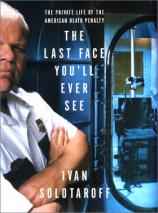The Last Face You'll Ever See: The Private Life of the American Death Penalty
Review
The Last Face You'll Ever See: The Private Life of the American Death Penalty
The American public is currently engaged in a serious debate over the continued wisdom and merit of capital punishment. In 1972 the United States Supreme Court invalidated state laws that allowed for the execution of those individuals convicted of murder. Justice Potter Stewart perhaps best described the shortcomings of the laws then in place when he wrote that such laws were, "cruel and unusual in the same way that being struck by lightning is cruel and unusual." Only "a capriciously selected random handful" get sentenced to death. Many states responded by enacting new laws that complied with the Supreme Court mandate to eliminate the freakish manner in which the death penalty had been imposed. As the new laws took effect and passed legal challenges, the number of inmates both executed and awaiting execution reached staggering counts. Execution, once front page news, became tiny blurbs deep in the newspaper, or often simply ignored.
By the late 1990s the pendulum began to swing against the imposition of capital punishment. Two major flaws became apparent. First, the problem of capriciousness was not eliminated but instead exacerbated. As individuals across the nation were sentenced to die, it became apparent that the death penalty was often the product of the individual whim of prosecutors, judges, and juries. More important, however, was the fact that many individuals were sentenced to die when in fact they were innocent of the crime for which they had been charged. In Illinois, as exonerations of innocent individuals wrongly convicted removed parties from death row at a higher rate than executions, Governor George Ryan finally imposed a moratorium on the imposition of the death penalty in his state. Public opinion that had once overwhelmingly favored capital punishment began to waver and decline.
THE LAST FACE YOU'LL EVER SEE by Ivan Solotaroff is a look at the death penalty through unusual eyes. Most Americans focus their attention on the victims of crime or the perpetrators. There is, however, a vast and often unseen bureaucracy that has been put in place in order to impose the punishment of death. To a great degree, the author concentrates on the executioners, specifically two men from Mississippi whose experiences are the foundation of THE LAST FACE.
Solotaroff's concern with the executioners had a purpose. He sought to discover who carried out executions --- where, when, and how --- and what it was like for them to do so. As he pondered these questions, he confronted a more important issue. Why do executioners do it? Or more exactly, why do we want them to do it? The two men portrayed by Solotaroff give us far different portrayals of what must be one of the more difficult jobs in law enforcement. Donald Hocutt has willingly carried out four executions. He has done so without qualms. After one execution, customers at the local McDonald's congratulated him on a job well done. Throughout his discussions with the author, Hocutt remains a staunch defender of the death penalty.
Don Cabana is not as steadfast in his support. The former superintendent of Parchman State Prison in Mississippi willingly participated in the execution of Connie Ray Evans. But during the 15 minutes it took Evans to die, Cabana began a reexamination of his position. After the execution he left his employment and traveled around the country testifying against the death penalty. In many ways these two men exemplify the argument swirling across America today; each is passionate in his own belief and each can find countless allies to support his position.
Along the way we meet other individuals with equally fervent positions. In Louisiana, Solotaroff interviews Wilbert Rideau and Douglas Dennis, editors of The Angolite, an award winning prison newspaper. Rideau is a fascinating individual who, in many ways, represents the dilemma faced by the capital punishment debate. He is a superb writer and an incisive man. He is also a vicious criminal. Life magazine once called him, "the most reformed man in America." He understands the randomness of capital punishment in America: "It's completely random, except of course for the fact that it's you, sitting in there and waiting for it to come, and that's as unrandom as you can get."
In the end, THE LAST FACE YOU'LL EVER SEE leaves us with an unfinished canvas that portrays only a portion of the picture that represents the death penalty in America. There are several faces that Solotaroff fails to portray, most importantly the victims of these brutal crimes and their survivors, who remain the most potent adversary for opponents of the death penalty. Ivan Solotaroff has made a valuable contribution to the debate and discussion surrounding the death penalty, and his book is important reading on the subject.
Reviewed by Stuart Shiffman on September 4, 2001
The Last Face You'll Ever See: The Private Life of the American Death Penalty
- Publication Date: September 4, 2001
- Genres: Nonfiction
- Hardcover: 256 pages
- Publisher: HarperCollins
- ISBN-10: 006017448X
- ISBN-13: 9780060174484




